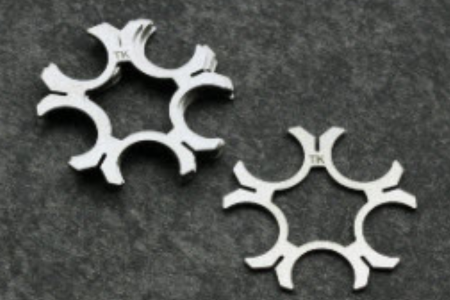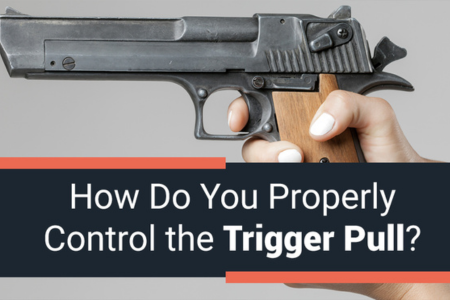So, you were recently at the range and had a difficult time seeing your gun’s sights because the ambient light in or around the range was very low. Short of the sun shining brighter or turning up the wattage on the range flood lights, what can you do about this low ambient light condition? You can change the sights on your gun to make the sights easier to see in low light or no light situations. There are two choices of aftermarket gun sights available. Which you choose is a personal preference. These choices are changing your factory gun sights for either Tritium sights or (Fiber) Optic sights. So, what are they and what are their similarities and differences?
Fiber Optic Sights

Fiber optics, or from here on out, simply “optics”, are made of transparent strings of plastic or glass. One string is super-thin, like human hair. However, the optical fibers in manufacturing gun sights are wider than usual. The feature that makes optical fiber popular is its speed and range. It can transfer light to as far as 200 miles per second, making it a top choice for telecommunications. When it comes to gun sights, the technology channels light pretty impressively. Fiber optics is almost reflective. It illuminates instantly by absorbing all the light hitting it. Because of this, the material is visible in varying lighting conditions. The gun sight itself, has an open top, so the glass strings can absorb ambient light. The sight then channels that absorbed light to the back of the sight and into the shooter’s eye.

Fiber optics come in a wide range of colors. You can get it made in any tone, but green and red are the most common for gun sights. Now you may wonder which color to go for. Try different colors and see which is bright enough to give you a clear sight picture. But generally, staying true to green or red for maximum efficiency and accuracy is recommended. In fact, green is a better light conductor than red is.
Knowledgeable shooters do not rely on the length of the sight to judge its efficacy. Rather, they use the width of the glass tube. The wider the glass tube, the more ambient light it can absorb. So, when shopping for or trying out different handguns, focus on the width rather than the length of the glass tube. However, there is a downside to judging the gun sight solely on its width. Often, wider optics, while providing good light, obstruct the target you are aiming at.

So, what are fiber optic sights good for? Fiber optic sights are not like ordinary night sights. They don’t generate illumination on their own. Instead, they glow when the light from the surrounding ambient light hits them. That is why fiber optics work amazingly well in broad daylight. A fiber optics sight is suitable for the daytime when the sun is blazing. The more intense the sunlight, the brighter the light will glow. As a result, it will also give a good and clear sight picture. Fiber optic sights are ideal for sport shooting. The sight’s small diameter rod offers precise shooting, while the rod illuminates in external environments. In fact, at my favorite outdoor range, there is significant tree cover during the spring and summer months. So much so, that if the wind blows the leaves just right, their shadow is cast directly onto my gun, reducing the ambient light hitting my gun. An optic sight was a perfect changeout for me.
The actual glass tube is more fragile than Tritium sights. Care must be taken on handling the gun. If the glass tube should break, many models are designed so the tube is replaceable. There are some optic “kits” available which includes the sight and interchangeable glass tubes. This will allow you to go from green to orange quickly, if you want to see if a different color provides a better sight picture.

Tritium Sights
Tritium is a hydrogen isotope (3H) that rarely occurs naturally. Instead, this is radioactive material and is mostly made artificially for illumination purposes. Radioactivity can be quite dangerous. But fortunately, tritium has relatively low energy. That makes it less harmful to humans but quite beneficial for lumination in guns. Tritium sights work just like a glow-in-the-dark toy. You have to expose them to a light source, and they will start generating their own light. Tritium does so through a phenomenon known as beta decay. It releases electrons that react with a phosphor material to produce light. The generated light is bright but not strong enough to affect the shooter’s night vision.
As with anything that is radioactive, its efficacy is measured in terms of “half-life”. When searching for tritium sights, you may have encountered the term “tritium half-life.” Ever wondered what that is? It is time a radioactive isotope takes to become half of its initial value. For instance, tritium’s half-life is estimated to be around 12.5 years. That means a tritium sight will start emanating light half as intense after this time period. But this doesn’t indicate that the light will become useless. Instead, it will just get a little dim. And for this reason alone, tritium sights can never be a permanent solution for firearms. No one can actually estimate the potency these instruments have. So, if you have a tritium sight on your gun and store the gun in your safe for lengths of time, you may notice the light given off by the sight may be duller than the last time you pulled the gun out of your safe.
Like fiber optics, tritium sights also come in multiple colors. If your main focus is on elongating the lifespan of your tritium sight, you must choose the color accordingly. That’s because every color degrades differently. For example, green tritium is an excellent and safe choice for dark environments. In addition, it is very durable, with a lifespan of 12 years. On the other hand, yellow tritium is also a good choice as it’s bright but comparatively dull than green. Yet, its lifespan is also 12 years. If you’re shooting at great distances, yellow tritium can cause strain to your eyes. Tritium also comes in orange. But it’s hardly used in guns as it’s less reflective and doesn’t allow the shooter to focus on the object in front. Orange tritium also has a relatively low lifespan of about 5 years.
So, what are tritium sights good for? Tritium sights work best in darkness. These are exceptional low-light night sights, making them ideal for defensive shooting. Moreover, their prominent footprint sight facilitates the shooter in quickly locating the front view. They are the ideal choice for defense firearms to help the shooter shoot accurately at the target. The best part is that tritium sights can be continuously illuminated, which is why they are also available in glow-in-the-dark clocks and wristwatches. You may also see them in exit or emergency signs and glow sticks.

So, Which Is Better?
Like just about everything in the gun owner’s world, as you can deduce, fiber optics and tritium sights are efficient for different situations. While the former works during the day, the latter is ideal for the nighttime. Fiber optics are less expensive, while tritium can be heavy on your pocket. So, which one do you think is better? Well, the answer comes down to your requirements. Ask yourself whether you’re going on a shooting adventure or want an everyday weapon. Then, go through the pros and cons of each sight and make the right choice. If you’re still clueless, here are a few factors to consider in order to find your answer:
Price
Regarding the price, fiber optics are less expensive than tritium sights. A little reminder: the former are transparent strings of plastic, while tritium is a radioactive isotope made artificially for illumination. On average, a fiber optic sight will come at almost half the price of its counterpart. So, if money is your concern, you should go for the fiber optic one.
Reliability
Fiber optics require a considerable amount of light to work, while tritium sights generate their own illumination. But don’t forget that tritium’s luminosity can degrade over time. It will become less effective in a few years, mainly because it continuously glows. If you keep your tritium sight in a drawer for years and take it out, you may find that its magic is gone. In the worst-case scenario, it may not even work entirely. On the other hand, fiber optics sights don’t need previous exposure to work. Also, the material doesn’t degrade over time.




Versability
The comparison between both sights ends at versatility. Fiber optics refracts light from the environment to give you a good view. But if you’re in dark surroundings and want to draw your firearm, you won’t be able to reap its full benefits. That’s when you’d need a tritium sight. When it’s daytime, the scenario is quite different. The tritium light won’t be noticeable under the sun, while fiber optics one would give an intense light.
Installing Aftermarket Sights

Installing them is dependent on your gun model. Many gun models have them held in with tiny screws, such as the image of the sight for my Ruger Mk-IV Target pistol. Others, like Glock and Walther, have a screw under the sight which has to be removed. Therefore, the slide, barrel and slide spring have to be removed to provide accessibility to the tiny screw on the underside of the muzzle. Still others, like the two images at the beginning of this blog, are held in place with a dovetail mount. They require a special pistol sight pusher too to push the sight through the dovetailing. The tool can be purchased on Amazon. If you are not comfortable doing it yourself, have a gunsmith do it.



